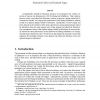Free Online Productivity Tools
i2Speak
i2Symbol
i2OCR
iTex2Img
iWeb2Print
iWeb2Shot
i2Type
iPdf2Split
iPdf2Merge
i2Bopomofo
i2Arabic
i2Style
i2Image
i2PDF
iLatex2Rtf
Sci2ools
86
Voted
DCC
2005
IEEE
2005
IEEE
Quantization of Multiple Sources Using Integer Bit Allocation
Asymptotically optimal bit allocation among a set of quantizers for a finite collection of sources was determined in 1963 by Huang and Schultheiss. Their solution, however, gives a real-valued bit allocation, whereas in practice, integer-valued bit allocations are needed. We compare the performance of the Huang-Schultheiss solution to that of an optimal integer-valued bit allocation. Specifically, we derive upper and lower bounds on the deviation of the mean squared error using optimal integer-valued bit allocation from the mean squared error using optimal real-valued bit allocation. One consequence shown is that optimal integer-valued bit allocations do not necessarily achieve the same performance as that predicted by Huang-Schultheiss, for asymptotically large transmission rates. We also prove that integer bit allocation vectors that minimize the Euclidean distance to the optimal real-valued bit allocation vector are optimal integer bit allocations.
Computer Graphics | DCC 2005 | Integer Bit Allocation | Optimal Bit Allocation | Optimal Integer Bit |
Related Content
| Added | 25 Dec 2009 |
| Updated | 25 Dec 2009 |
| Type | Conference |
| Year | 2005 |
| Where | DCC |
| Authors | Benjamin Farber, Kenneth Zeger |
Comments (0)

